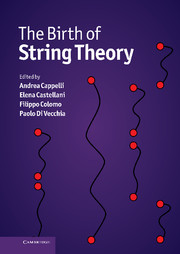Book contents
- Frontmatter
- Contents
- List of contributors
- Photographs of contributors
- Preface
- Abbreviations and acronyms
- Part I Overview
- EARLY STRING THEORY
- Part II The prehistory: the analytic S-matrix
- Part III The Dual Resonance Model
- Part IV The string
- TOWARDS MODERN STRING THEORY
- Part V Beyond the bosonic string
- Part VI The superstring
- Part VII Preparing the string renaissance
- 42 Introduction to Part VII
- 43 From strings to superstrings: a personal perspective
- 44 Quarks, strings and beyond
- 45 The rise of superstring theory
- Appendix A Theoretical tools of the Sixties
- Appendix B The Veneziano amplitude
- Appendix C From the string action to the Dual Resonance Model
- Appendix D World-sheet and target-space supersymmetry
- Appendix E The field theory limit
- Index
42 - Introduction to Part VII
from Part VII - Preparing the string renaissance
Published online by Cambridge University Press: 05 May 2012
- Frontmatter
- Contents
- List of contributors
- Photographs of contributors
- Preface
- Abbreviations and acronyms
- Part I Overview
- EARLY STRING THEORY
- Part II The prehistory: the analytic S-matrix
- Part III The Dual Resonance Model
- Part IV The string
- TOWARDS MODERN STRING THEORY
- Part V Beyond the bosonic string
- Part VI The superstring
- Part VII Preparing the string renaissance
- 42 Introduction to Part VII
- 43 From strings to superstrings: a personal perspective
- 44 Quarks, strings and beyond
- 45 The rise of superstring theory
- Appendix A Theoretical tools of the Sixties
- Appendix B The Veneziano amplitude
- Appendix C From the string action to the Dual Resonance Model
- Appendix D World-sheet and target-space supersymmetry
- Appendix E The field theory limit
- Index
Summary
Introduction
The period between the years 1976 and 1984 shows very little activity in string theory. As we mentioned in the previous Part, a lot of work went into developing both perturbative and nonperturbative aspects of QCD, which established itself as the theory of strong interactions. Lattice gauge theory was formulated and the idea of confinement was developed. These were also the years when supersymmetry was used to construct the Minimal Supersymmetric Standard Model, and the various supergravities were obtained. The most fundamental of them, constructed by Cremmer, Julia and Scherk, was the eleven-dimensional one. The fact that the various supergravities showed better ultraviolet behaviour than the original gravity theory gave the hope that one could unify gauge interactions with gravity in the framework of supergravity without nonrenormalizable divergences. On the other hand, the machinery of string theory seemed too complicated and unnecessary for unification. We review these developments in Section 42.2.
Although research in string theory was very limited in these years, it led to three fundamental developments. The first one, discussed in the Chapter by Green, was the reformulation of the fermionic string in terms of a light-cone fermionic coordinate Sa, that is an SO(8) spinor, instead of the light-cone SO(8) vector ψi of the RNS model. This allowed the complete construction of type IIA, IIB and I superstring theories. It is described in Section 42.3.
- Type
- Chapter
- Information
- The Birth of String Theory , pp. 511 - 526Publisher: Cambridge University PressPrint publication year: 2012

